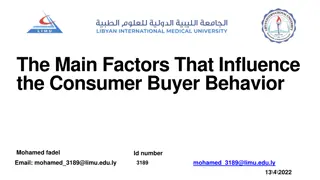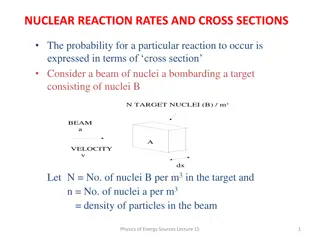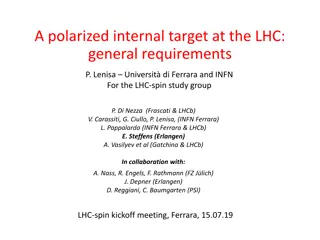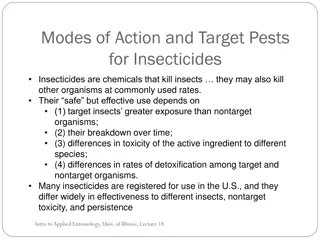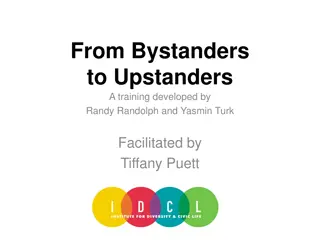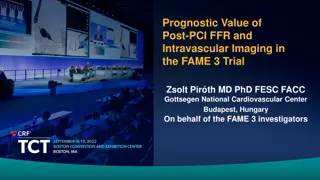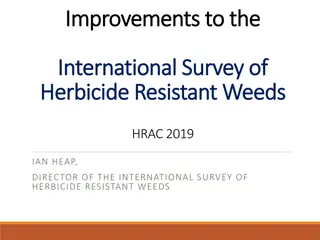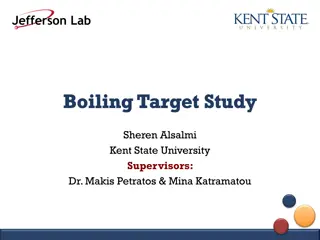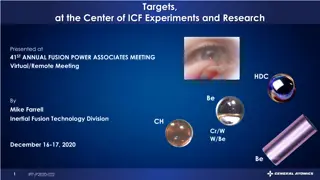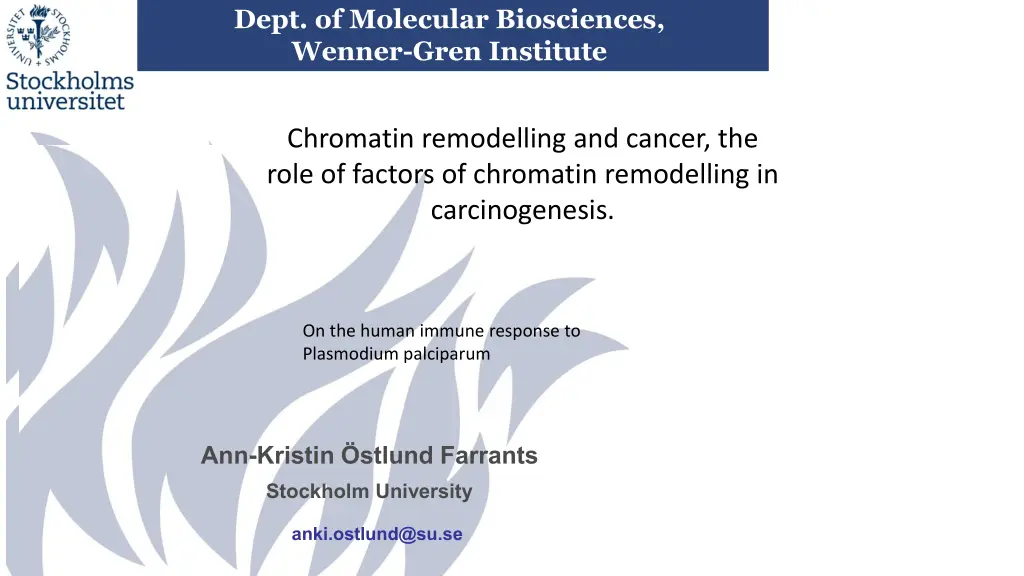
Chromatin Remodelling in Cancer and Immune Response to Pathogens
Explore the role of chromatin remodelling in carcinogenesis and the human immune response to pathogens such as Plasmodium falciparum. Understand how changes in chromatin states impact gene expression and cellular differentiation, and the enzymes and factors involved in this process. Discover the regulatory mechanisms governing altered gene expression patterns and the implications for carcinogenic transformation and nuclear reprogramming.
Download Presentation

Please find below an Image/Link to download the presentation.
The content on the website is provided AS IS for your information and personal use only. It may not be sold, licensed, or shared on other websites without obtaining consent from the author. If you encounter any issues during the download, it is possible that the publisher has removed the file from their server.
You are allowed to download the files provided on this website for personal or commercial use, subject to the condition that they are used lawfully. All files are the property of their respective owners.
The content on the website is provided AS IS for your information and personal use only. It may not be sold, licensed, or shared on other websites without obtaining consent from the author.
E N D
Presentation Transcript
Dept. of Molecular Biosciences, Wenner-Gren Institute Chromatin remodelling and cancer, the role of factors of chromatin remodelling in carcinogenesis. On the human immune response to Plasmodium palciparum anki.ostlund@su.se Anna Rolicka Toni Ga ez Zapater Yuan Guo Jaclyn Quin Ioana Buijila Ann-Kristin stlund Farrants Stockholm University anki.ostlund@su.se
The eukaryotic genome, DNA, is organised in chromatin Nucleosome Histone core - - Forms a barrier for transcription factors to get access to the DNA Protects the DNA from damage
The dynamic chromatin structure in cells Inactive, heterochromatin Me HP1 HP1 HP1 me RNA At least 7 different packaging stages Ac Active, euchromatin mRNA/rRNA Ac
The chromatin states change in response to external cues Waddington s epigenetic landscape -DNA methylation silencing -Histone modifications -Nucleosome spacing Results in changes in the expression profile, Genes are silent and others induced Differentiation, activation
The change requires enzymes Inactive Me me RNA -ATP-dependent chromatin remodelling complexes -DNA methylases/demethylases -Enzymes Modifying the histones (Acetylation-methylation) -RNA polymerases??? Ac Active mRNA/rRNA Ac
Allows for factors to bind Inactive Me me RNA Enzymes: -DNA methylases/demethylases -ATP-dependent chromatin remodelling complexes -Enzymes Modifying the histones -RNA polymerases??? TF Ac Active Ac mRNA/rRNA
Altered gene expression pattern Inactive Me me RNA How is the change regulated: Enzymes: TF TF, RNA, chromatin -Pioneering transcription factors -RNA -Chromatin features DNA methylases/demethylases ATP-dependent chromatin remodelling complexes Enzymes Modifying the histones RNA polymerases??? Ac Active Ac mRNA/rRNA
Carcinogentic transformation; nuclear reprogramming to a more pluripotent stem cell like state Drivers are; Mutations (often gain of function) or overexpression of proto-oncogenes: key transcription factors c-Myc, signal transduction effectors c-Ras, DNA repair poteins BRCA) Loss of function of tumour supressors: RB, PTEN, p53 Viruses: papiloma, EBV Proliferative/self renewal Changed gene expression profile Common Characteristics: Resisting cell death and senescence The genome is instable
The chromatin structure is changed during malignant transformation: changed DNA-methylation pattern, histone modifications pattern Nucleosome arrangements changed Altered gene expression pattern
The chromatin structure is changed during malignant transformation: changed DNA-methylation pattern, histone modifications pattern Nucleosome arrangements changed Chromatin remodelling and modifying enzymes are dysregulated later in the malignant progression
Genomic instability Change the gene expression pattern The chromatin and chromatin remodelling enzymes are keepers of the integrity of DNA and proper gene expression. Chromatin remodelling and modifying enzymes are dysregulated later in the malignant progression
SWI/SNF complexes Large complexes associated with transcription recruited to specific genes by transcription factors Mutated in 20% of cancers Tumour supressor C-Myc me
Required by a number of key pioneering factors, important during development + Counteracts repressing chromatin states by Pc (polycomb) and the histone demethylase Ezh2 Hohmann, 2014 Target in cancer therapy
Cancer cell lines have shorter mRNA Cancer cells express other splice variants Can SWI/SNF affect splicing outcome, and is this contributing to cancer intron exon exon me me me me me me
Genomic stability -Chromatin protects DNA and allows for repair DNA damage occurs naturally in the cell: Replication stalled replication forks, DNA structure (AT-rich, Common fragile sites or in transcription units Recombination events, repetetive sequences Transcription R-loops, stalled RNA pol DNA damage internal/external, open chromatin more sensitive
A changed chromatin landscape can result in genomic instability Open chromatin is more sensitive to DNA-damage Instability is manifested by: DNA breaks DNA damage More mutations appear Polyploidy, aneuploidy Copy-number changes of chromosome segments
Chromatin remodelling complexes are necessary in DNA repair INO80 clears DNA from nucleosomes at the break DNA repair mashinery Before the break loads H2AX into active chromatin INO80
The nucleoli are affected in cancer, more nucleoli and usually differnt morphology Used as a diagnostic tool
The nucleolus is the centre for ribosomal transcription and assembly Ruggero and Pandolfi, 2003
Ribosomal transcription and the nucleolus 400 gene copies on 10 chromosomes More than half in heterochromatin in differentiated cells Ruggero and Pandolfi, 2003
The size and the number also change during proliferative stimulation reflects the increased needs for protein synthesis The number of nuclei and increases and their conformation changes during differentiation The number of nucleoli and their size increase upon proliferative stimuli Unstimulated stimulated Lymphocytes Biochimica et Biophysica Acta (BBA) - Molecular Basis of Disease, Volume 1842, Issue 6, 2014, 802 816
The transcription is under the control of proliferative signals, nutrients, c-Myc, p53 and RB AKT MAPK A PI3K POL I RRN3 mTOR TT F1 UBF SL1 C-Myc
And also by chromatin and chromatin remodelling complexes B-WICH 200 bp over the transcription start site is remodelled in the presence of WSTF- MNase walking Pol I
Ribosomal transcription is often dysregulated in tumour cells To meet the need of ribosomes Not gain of function of RNA pol I machinery, rather the regulatory proteins c-Myc, Rb, p-53 Chromatin? Nucleolus and ribosomal transcription is a stress centre DNA damage, hypoxia Ribosomal pertubation induces cell cycle arrest G1/S p53 dependet apoptosis
Not all cancer cells have larger nucleoli or have a higher rate of ribosomal transcription p53 or Rb minus cells more sensitive to ribosomal disruptions The chromatin structure is changed at the locus, more genes are in an open configuration without being transcribed
P53 or Rb minus cells more sensitive to ribosomal disruptions One idea is that the level of ribosome will get too low - Leads to cell death One idea is that more instable locus, more recombination and DNA damage Ribosomal transcription is now targeted in cancer treatments







